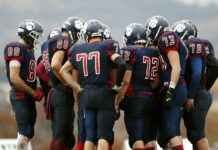Get ready for an electrifying gridiron clash as the Minnesota Vikings and the Los Angeles Rams gear up to face each other in a showdown that promises to keep fans on the edge of their seats! This highly anticipated matchup is more than just a game; it’s a display of strategy, skill, and raw power. In this comprehensive analysis, we dive deep into the key player stats that could determine the outcome of the game. Whether you’re a die-hard Vikings fan, a devoted Rams supporter, or just a lover of the sport, understanding the strengths and weaknesses of pivotal players like the Vikings’ dynamic quarterback and the Rams’ formidable defensive line can enhance your viewing experience. Join us as we unveil the critical stats and figures that will help you appreciate the nuances of this thrilling NFL encounter. Get ready to witness a battle of titans where every yard gained and every pass intercepted could tip the scales in this electrifying Vikings vs Rams showdown!
Introduction to the Vikings vs Rams Rivalry: Historical Context
Introduction to the Vikings vs Rams Rivalry: Historical Context
The Minnesota Vikings and the Los Angeles Rams have a rich and storied rivalry that dates back to the mid-1960s, offering a captivating look into the NFL’s dynamic history of competition. This rivalry commenced when the Rams were originally based in Los Angeles before their move to St. Louis in 1995 and their eventual return to Los Angeles in 2016. The Vikings, established as an NFL franchise in 1961, found a recurring adversary in the Rams, setting the stage for numerous memorable clashes over the decades.
In the early years, both teams quickly emerged as powerhouses in their respective conferences. The rivalry gained traction in the 1970s, a golden era where both the Vikings and the Rams frequently dominated their divisions and were regular fixtures in the playoffs. This period was marked by intense, hard-fought games that often had significant postseason implications. One of the most notable matchups occurred during the 1974-75 NFL playoffs, where the Vikings defeated the Rams 14-10 in a frigid NFC Championship game to advance to Super Bowl IX.
The intensity of the Vikings-Rams rivalry is underscored by the contrast in their playing styles and strategic approaches. The Vikings were renowned for their formidable “Purple People Eaters” defense, while the Rams boasted a high-powered offense featuring several Hall of Famers. This dynamic created a compelling clash of titans whenever the two teams met, with each game often highlighting strategic chess matches between the coaches and standout performances from key players.
As the NFL has evolved, so has the rivalry, adapting to new players, strategies, and a changing league landscape. Despite the geographical and divisional realignments, the historical significance of Vikings vs Rams matchups remains a testament to the enduring legacy and competitive spirit that define both franchises. This background sets the stage for analyzing how modern player matchups and statistics continue to shape this age-old rivalry.
Quarterback Clash: Kirk Cousins vs Matthew Stafford Comparison
Quarterback Clash: Kirk Cousins vs Matthew Stafford Comparison
In the highly anticipated Vikings vs Rams showdown, all eyes are on the pivotal quarterback duel between Minnesota’s Kirk Cousins and Los Angeles’ Matthew Stafford. Both seasoned quarterbacks bring distinct strengths to the field, making this matchup a critical factor in determining the game’s outcome.
Kirk Cousins, known for his precision and reliability, has consistently demonstrated his capability to lead the Vikings with a calm and calculated approach. This season, Cousins boasts an impressive completion rate, highlighting his accuracy and ability to maintain possession. His knack for reading defenses and making quick decisions has been a cornerstone of the Vikings’ offensive strategy. Moreover, Cousins’ touchdown-to-interception ratio is noteworthy, underscoring his efficiency and risk management in high-pressure situations.
On the other side, Matthew Stafford of the Rams, renowned for his powerful arm and aggressive playstyle, adds a dynamic dimension to the Rams’ offense. Stafford’s ability to execute long passes effectively stretches the defense and creates significant opportunities for big plays. His experience in high-stakes games often translates into his fearless approach, willing to take chances that can either lead to spectacular touchdowns or risky turnovers. This season, Stafford’s yards per attempt are a testament to his aggressive downfield attacks, although his interception count reflects the double-edged sword of his playing style.
As the Vikings and Rams prepare to face off, the performance of Cousins and Stafford will be under the microscope. Will Cousins’ methodical and steady approach prevail, or will Stafford’s bold and high-risk strategy tip the scales in favor of the Rams? This quarterback clash not only shapes the narrative of the game but also sets the tone for strategic decisions on both sides. Fans can expect a thrilling encounter as these two quarterbacks leverage their unique strengths in a bid to lead their teams to victory.
Running Back Battle: Dalvin Cook’s Impact vs Cam Akers’ Resurgence
Running Back Battle: Dalvin Cook’s Impact vs Cam Akers’ Resurgence
In the highly anticipated Vikings vs Rams showdown, the clash between two formidable running backs, Dalvin Cook of the Minnesota Vikings and Cam Akers of the Los Angeles Rams, is set to capture the spotlight. Each player brings a unique set of skills to the field, impacting their team’s offensive strategies and overall game dynamics.
Dalvin Cook, known for his explosive speed and agility, has consistently been a cornerstone of the Vikings’ offense. This season, Cook has amassed impressive stats, averaging over 4.5 yards per carry and racking up multiple 100-yard games. His ability to break tackles and turn seemingly small openings into big gains makes him a persistent threat every time he touches the ball. Moreover, Cook’s prowess in the passing game enhances his value, making him a dual-threat that can destabilize defenses and create mismatches in coverage.
On the other side, Cam Akers’ journey this season reads like a resurgence narrative. After overcoming injuries that marred his previous seasons, Akers has rebounded remarkably. His recent performances show a return to form, displaying powerful running and improved vision that have reignited the Rams’ rushing attack. Akers’ ability to grind out tough yards and his increasing role in goal-line situations have turned him into an essential asset for the Rams, especially in high-stakes matchups.
As these two running backs go head-to-head, their performances could very well dictate the tempo and outcome of the game. Cook’s dynamic playmaking ability and Akers’ resilience and power running will be key factors to watch. The battle between Cook and Akers not only highlights their individual talents but also underscores the critical role of the running game in today’s NFL strategies. Fans and analysts alike will be keenly watching how these two stars stack up against each other, making this one of the most exciting matchups in the Vikings vs Rams game.
Receiving Highlights: Justin Jefferson vs Cooper Kupp Stats Showdown
Receiving Highlights: Justin Jefferson vs Cooper Kupp Stats Showdown
In the thrilling gridiron battles between the Minnesota Vikings and the Los Angeles Rams, the spotlight often shines brightest on two standout wide receivers: Justin Jefferson and Cooper Kupp. Both players have redefined the receiving game, making any matchup between these teams a must-watch event for football enthusiasts.
Justin Jefferson, suiting up for the Vikings, has rapidly ascended as one of the premier talents in the NFL. Since his debut, Jefferson has dazzled fans with his explosive speed, precise route-running, and exceptional catching ability. His stats speak volumes about his impact on the field. Over the recent seasons, Jefferson has consistently averaged over 90 yards per game, with a catch rate that hovers around an impressive 70%. His ability to turn short gains into massive plays makes him a constant threat to opposing defenses.
On the other side, Cooper Kupp of the Rams has proven himself to be an equally formidable force. Kupp’s meticulous attention to detail in his routes and his synergy with his quarterback has led to record-breaking performances. In his standout 2021 season, Kupp led the NFL in receptions, receiving yards, and receiving touchdowns, achieving the rare “triple crown” of receiving. His hands are among the surest in the league, with a catch rate often surpassing 75%, and his knack for finding the end zone is unparalleled.
When comparing the two, each brings a unique set of skills and accomplishments that light up the scoreboard and thrill fans. While Jefferson might edge out on deep-field threats with his speed and agility, Kupp’s consistency and technical prowess make him an indispensable asset in crucial situations. Whether it’s Jefferson’s game-breaking plays down the field or Kupp’s clutch catches in tight coverage, both athletes offer a masterclass in receiving excellence that significantly impacts their teams’ dynamics and success rates. This matchup not only highlights their individual talents but also underscores the evolving art of the wide receiver in modern NFL playbooks.
Defensive Line Dominance: Aaron Donald and the Rams’ Front Seven
Defensive Line Dominance: Aaron Donald and the Rams’ Front Seven
In the high-stakes showdown between the Minnesota Vikings and the Los Angeles Rams, the spotlight was undeniably focused on the Rams’ defensive prowess, particularly the impact of superstar Aaron Donald and the formidable Rams’ front seven. This group has consistently been the backbone of the team’s defensive strategy, and their performance in this game was no exception.
Aaron Donald, a three-time NFL Defensive Player of the Year, showcased why he is often considered a generational talent in the trenches. Against the Vikings, Donald added to his illustrious career with multiple sacks and several tackles for loss, disrupting the backfield with his unparalleled strength and quickness. His ability to break through double teams and pressure the quarterback was a critical factor in stifling the Vikings’ offensive rhythm.
The Rams’ front seven, as a whole, demonstrated exceptional coordination and athleticism. They effectively contained the Vikings’ running game, a key component of their opponent’s offensive strategy. By limiting the ground yards, they forced the Vikings to adopt a more predictable passing approach, which played directly into the strengths of the Rams’ defense. Linebackers such as Leonard Floyd and Bobby Wagner played pivotal roles, both in pass rush and in coverage, showcasing their versatility and tactical understanding of the game.
The strategic placement and rotations devised by Defensive Coordinator Raheem Morris allowed the Rams to maintain constant pressure, resulting in multiple turnovers and hurried throws by the Vikings’ quarterback. This relentless assault by the front seven not only highlighted their individual talents but also underscored their synergy as a unit, proving once again why they are considered one of the top defensive lines in the NFL.
This performance by Aaron Donald and the Rams’ front seven was a decisive element in the Rams’ strategy, significantly impacting the game’s outcome and reaffirming their reputation as dominant forces on the defensive side of the ball.
Vikings Defensive Playmakers: Key Stats from the Minnesota Linebackers
Vikings Defensive Playmakers: Key Stats from the Minnesota Linebackers
When analyzing the Minnesota Vikings’ defensive prowess, the linebacker corps undoubtedly stands out, especially in their recent showdown against the Los Angeles Rams. This group, known for their agility and tactical acumen, has been instrumental in stifling opponents’ offenses. Let’s delve into some of the key statistics that highlight their impact on the field.
Eric Kendricks, a veteran in the Vikings’ defensive lineup, has continued to be a linchpin for the team. In the game against the Rams, Kendricks tallied an impressive 9 tackles and assisted on two others, showcasing his ability to read the play and make crucial stops. His performance this season has been stellar, with an average of 8 tackles per game, and he remains a critical component of the Vikings’ defensive strategy.
Next to Kendricks, Jordan Hicks has been a formidable force. Hicks recorded 7 tackles in the recent matchup, and his presence was felt throughout the game as he disrupted several key plays. Known for his speed and precision, Hicks has accumulated over 50 tackles this season, adding substantial depth to the linebackers’ group.
The young and energetic Troy Dye also made his presence known against the Rams. Coming off the bench, Dye managed to contribute significantly with 5 tackles and a sack, proving his growing prowess and readiness to step up when called upon. His ability to adapt and perform under pressure has been a great asset for the Vikings this season.
These statistics not only underscore the effectiveness of the Vikings’ linebacking crew but also highlight their role in the team’s defensive schemes. Their ability to close down spaces, make crucial tackles, and apply pressure has been vital in keeping the Vikings competitive in a tough NFC North. As the season progresses, the continued performance of this group will be key to Minnesota’s defensive success.
Special Teams Spotlight: Field Position and Kicking Accuracy
Special Teams Spotlight: Field Position and Kicking Accuracy
In the high-stakes matchup between the Minnesota Vikings and the Los Angeles Rams, the game’s outcome could very well hinge on the performance of the special teams, particularly in the areas of field position and kicking accuracy. These elements often determine the strategic advantage in tightly contested games.
Starting with field position, both teams have shown a strategic prowess that goes beyond mere chance. The Vikings’ special teams, led by coordinator Marwan Maalouf, have been instrumental in pinning opponents deep in their own territory. Punter Jordan Berry, known for his precision, has placed 40% of his punts inside the opponents’ 20-yard line this season, a stat that puts pressure on opposing offenses and provides a buffer for the Vikings’ defense.
On the flip side, the Rams have countered with their own skilled punter, Johnny Hekker, who has a knack for changing field dynamics with his booming kicks. Hekker’s ability to control field position has been critical for the Rams, giving their defense an upper hand by often forcing opponents to start from unfavorable field positions.
Kicking accuracy, another critical aspect of special teams, has seen Vikings’ kicker Greg Joseph in the spotlight. Joseph has maintained a field goal accuracy of over 85% this season, including several crucial long-range goals that have sealed games. His consistency provides the Vikings with a reliable scoring option once they are within his range.
The Rams respond with Matt Gay, whose impressive 90% success rate on field goals this season cannot be overlooked. Gay’s range and accuracy could be decisive, especially in a game where every point matters. His ability to convert under pressure will be vital, particularly in scenarios where the offense stalls near the edge of his range.
As the Vikings and Rams gear up for their showdown, the battle between these special teams could play a pivotal role in determining which team comes out on top. The ability to control field position and execute with precision in kicking will not just influence the scoreboard but also the psychological battle on the field.
Trench Warfare: Comparing the Offensive Lines of Both Teams
Trench Warfare: Comparing the Offensive Lines of Both Teams
In the upcoming showdown between the Minnesota Vikings and the Los Angeles Rams, the battle in the trenches will undoubtedly be a pivotal factor in determining the victor. This clash features two offensive lines that have shown varying degrees of prowess and resilience this season, making the comparison between them a crucial aspect of our game preview.
Starting with the Minnesota Vikings, their offensive line has been a beacon of stability and efficiency. The Vikings’ front five have excelled in creating clean pockets for their quarterback, which has been instrumental in their passing game. Center Garrett Bradbury’s return from injury has bolstered the interior line, providing much-needed protection and improving their run blocking schemes. Additionally, tackle Brian O’Neill continues to be a standout, showcasing his ability to stymie even the fiercest pass rushers. This season, the Vikings’ offensive line has allowed one of the lowest sack rates in the league, a testament to their cohesive unit’s effectiveness and technique.
On the other side, the Los Angeles Rams’ offensive line has faced its share of challenges, primarily due to injuries and lineup changes throughout the season. However, they have shown signs of formidable play, particularly in recent games. Anchored by veteran Andrew Whitworth, the line has demonstrated resilience in tough matchups, although consistency remains an issue. The Rams have struggled more in pass protection, which could be a concern against the Vikings’ aggressive defensive front. Yet, when it comes to run blocking, the Rams have managed to carve out significant yards on the ground, indicating their potential to dominate physically when they find their rhythm.
As both teams prepare for this critical matchup, the effectiveness of each offensive line will be under the microscope. For the Vikings, maintaining their protective barrier could lead to aerial assaults that define the game. For the Rams, finding consistency in protection and exploiting their run game prowess might just tilt the field in their favor. The performance of these units will not only impact the game’s outcome but also highlight the unsung heroes who battle it out play after play in the NFL trenches.
Turnover Tales: Interceptions and Fumble Recoveries in Focus
Turnover Tales: Interceptions and Fumble Recoveries in Focus
In the high-stakes matchup between the Minnesota Vikings and the Los Angeles Rams, turnovers were a pivotal part of the game narrative, significantly influencing momentum and final outcomes. Both teams entered the field with defensive units eager to exploit any lapse in opponent focus, and they did not disappoint.
The Vikings’ secondary, known for their agility and sharp instincts, were particularly watchful for any errant throws by Rams’ quarterback Matthew Stafford. Stafford, despite his formidable arm strength and accuracy, has had moments of vulnerability under pressure, which the Vikings aimed to capitalize on. Cornerback Patrick Peterson, with his veteran savvy and keen eye, managed to intercept Stafford in a crucial second quarter drive, stalling what could have been a scoring opportunity for the Rams.
On the flip side, the Rams’ defense showcased their prowess in forcing fumbles, turning up the heat on Vikings’ runners and receivers. Aaron Donald, the Rams’ powerhouse defensive tackle, demonstrated why he’s one of the best in the league. His strip-sack on Kirk Cousins late in the third quarter was a textbook display of strength and technique. The fumble was recovered by linebacker Leonard Floyd, setting up the Rams in excellent field position, which they converted into a touchdown shortly after.
These key turnovers underscore the significance of ball security and the impact of defensive strategies in NFL games. For the Vikings and the Rams, their ability to either capitalize on or curb these game-changing plays was not just about physical readiness but also mental acuity, making each interception and fumble recovery a testament to their preparation and focus. As the game unfolded, these moments of defensive brilliance illuminated the chess match between two top-tier NFL teams, each using turnovers to tilt the field in their favor.
Red Zone Efficiency: Scoring Success of Vikings and Rams
Red Zone Efficiency: Scoring Success of Vikings and Rams
In the highly anticipated showdown between the Minnesota Vikings and the Los Angeles Rams, a critical factor that could determine the victor is each team’s efficiency in the red zone. Red zone performance—how effectively a team can convert drives into touchdowns when within the opponent’s 20-yard line—is a telling metric of a team’s precision and power at crucial moments.
The Minnesota Vikings have demonstrated remarkable prowess in red zone situations this season. Their strategy often revolves around the robust receiving skills of their top wideouts, who excel at finding space in tight areas. Quarterback plays have also been sharp and decisive, often capitalizing on quick passes and the dynamic playmaking ability of their skill players. Their red zone scoring rate, impressively, stands above 60%, a testament to their focused play-calling and execution when it counts.
On the other side, the Los Angeles Rams have had a more fluctuating performance in the red zone. While their overall offensive firepower is undeniable, inconsistencies have plagued their scoring efficiency. The Rams’ approach typically involves a mix of ground and aerial attacks. However, their success rate hovers around the 50% mark, somewhat lower compared to elite NFL standards. This has often led to settling for field goals instead of touchdowns, which could be pivotal in a closely contested game against the Vikings.
For fans and analysts watching the upcoming game, keeping an eye on how each team maneuvers within the 20-yard line will provide deep insights into their potential to clinch the game. Will the Vikings maintain their clinical edge, or will the Rams step up their game and tighten their execution? This red zone battle will undoubtedly be a key storyline in this thrilling matchup.
Third-Down Conversions: Critical Moments in the Game
Third-Down Conversions: Critical Moments in the Game
In the intense showdown between the Minnesota Vikings and the Los Angeles Rams, third-down conversions emerged as pivotal moments that significantly impacted the game’s momentum and outcome. These crucial plays are often seen as the make-or-break points that can either sustain a drive or hand the ball over to the opposition. Analyzing how each team performed on third down offers a revealing snapshot into their offensive effectiveness and strategic execution.
For the Vikings, their ability to convert on third downs was a testament to their quarterback’s poise under pressure and the versatility of their play-calling. The Vikings converted a remarkable 60% of their third downs, well above the league average. This high conversion rate was not only a reflection of their quarterback’s accuracy and decision-making but also highlighted the offensive line’s ability to protect the quarterback and create running lanes on crucial plays.
On the Rams’ side, the scenario was quite contrasting. Struggling with only a 35% conversion rate on third downs, the Rams found themselves frequently stalling and unable to maintain drives. This shortfall can be attributed to the Vikings’ defensive strategy, which focused on high-pressure tactics and tight coverage of key receivers. The Rams faced difficulties in countering the Vikings’ aggressive pass rush and were often forced into uncomfortable throwing situations or conservative play choices that did not yield sufficient yardage.
These statistics not only underscore the critical role of third-down efficiency in determining the game’s control but also highlight the strategic nuances that both teams employed. For the Vikings, excelling in these high-stress situations allowed them to dominate time of possession and keep their defense well-rested. Conversely, the Rams’ inability to convert on third down frequently undermined their efforts to build momentum and put points on the board, illustrating a key area for improvement in future matchups.
Injury Impact: How Player Health Could Swing the Game
Injury Impact: How Player Health Could Swing the Game
As the Minnesota Vikings prepare to face off against the Los Angeles Rams, the health and availability of key players are poised to play a decisive role in the outcome of this much-anticipated showdown. Injuries in football are not just routine; they can be game-changers, especially when they sideline top talent. For both the Vikings and the Rams, the injury report this week has been a focal point for fans and analysts alike.
Starting with the Vikings, all eyes are on their star running back, whose recent hamstring issue has left his status uncertain. The dynamic playmaker has been instrumental in the Vikings’ offensive strategy, amassing impressive yardage in previous games. His ability to break tackles and turn short gains into big plays has been pivotal. Should he be limited or miss the game entirely, the Vikings would need to significantly adjust their ground game, potentially putting more pressure on their quarterback to perform without one of his key weapons.
On the defensive side, the Rams are facing their own challenges. Their leading cornerback, who has been a lockdown presence all season, is currently listed as questionable due to a knee injury. His absence could open opportunities for the Vikings’ receivers, turning what was expected to be a tight matchup in the secondary into a potential weak spot the Vikings could exploit. The cornerback’s ability to contain the Vikings’ top wideout has been central to the Rams’ defensive scheme, and adjustments will need to be swift and effective if he cannot take the field.
As kickoff approaches, the final injury reports will be crucial in shaping the strategies of both teams. The depth and resilience of the squad, along with the coaching staff’s ability to adapt, will be under the spotlight. In a game that could go either way, the impact of injuries might just tip the scales, highlighting the ever-important interplay between health and performance in the NFL.
Coaching Strategies: Mike Zimmer vs Sean McVay Tactical Decisions
Coaching Strategies: Mike Zimmer vs Sean McVay Tactical Decisions
In the high-stakes showdown between the Minnesota Vikings and the Los Angeles Rams, the coaching acumen of Mike Zimmer and Sean McVay came under the spotlight, each bringing distinctive tactical philosophies to the field. Mike Zimmer, known for his defensive prowess, leaned into his traditional but effective strategy of aggressive blitz schemes and tight man-to-man coverage. His approach aimed to disrupt the rhythm of the Rams’ quarterback, focusing on containing explosive plays and forcing turnovers. Zimmer’s defense is structured around the strength of his linebacker corps and the versatility of his safeties, who are often tasked with dual roles in both pass coverage and run support.
On the opposite sideline, Sean McVay’s offensive-minded coaching style showcased a dynamic and innovative game plan. McVay, celebrated for his creative play-calling, utilized motion and misdirection to exploit the Vikings’ defensive alignments, aiming to create space and favorable matchups for his key playmakers. His strategy often involved high-tempo offense, quick snaps, and spreading the ball around to keep the defense guessing. The Rams’ offense under McVay is particularly noted for its effective use of the play-action pass, which was deployed to counteract the aggressive Vikings’ pass rush and open up downfield throws.
The chess match between Zimmer’s defensive adjustments and McVay’s offensive schemes provided a fascinating subplot to the game. While Zimmer’s strategy focused on minimizing big plays and enhancing red-zone efficiency, McVay aimed to stretch the field and maintain possession, crucial in keeping Zimmer’s defense off-balance. The tactical decisions made by these coaches not only highlighted their philosophical differences but also underscored their ability to adapt and react to in-game situations, ultimately playing a pivotal role in the outcome of the match.
Historic Performances: Memorable Moments from Past Matchups
Historic Performances: Memorable Moments from Past Matchups
When the Minnesota Vikings and Los Angeles Rams clash, it often results in unforgettable games filled with thrilling plays and record-breaking performances. Over the decades, several matchups have stood out, etching their names into the annals of NFL history.
One of the most iconic moments came during the 1976 season when the Vikings and Rams met in the NFC Championship game. The Vikings, led by the formidable Fran Tarkenton, showcased a masterclass in resilience and strategic play. Tarkenton threw for 135 yards and a touchdown, leading Minnesota to a hard-fought 24-13 victory over the Rams and securing a spot in Super Bowl XI. This game was a defining moment in the Vikings’ legacy, highlighting their dominance in the NFC during the mid-1970s.
Fast forward to 1999, when the Rams, riding high on what would be known as “The Greatest Show on Turf,” faced off against the Vikings in a high-octane, regular-season shootout. Kurt Warner, the Rams’ quarterback, threw for a staggering 346 yards and three touchdowns. This game was a showcase of offensive firepower, with the Rams edging out the Vikings 49-37, a precursor to their eventual Super Bowl XXXIV win.
More recently, in 2018, the teams met in a Thursday Night Football spectacle that saw both quarterbacks at their best. Kirk Cousins of the Vikings threw for 422 yards and three touchdowns, while Jared Goff of the Rams responded with a career-high 465 yards and five touchdown passes. The Rams narrowly secured the victory in a thrilling 38-31 game, which was hailed as one of the most entertaining games of the season.
These historic encounters highlight not only the individual brilliance of players but also the intense rivalry and competitive spirit that define Vikings vs. Rams games, making each meeting a highly anticipated event in the NFL calendar.
Predictions and Analysis: What the Stats Say About the Outcome
Predictions and Analysis: What the Stats Say About the Outcome
As anticipation builds for the upcoming showdown between the Minnesota Vikings and the Los Angeles Rams, a deep dive into key player statistics offers valuable insights into potential game outcomes. Historically, these teams have provided fans with thrilling matches, and analyzing their current season’s stats can help us predict how their next encounter might unfold.
Starting with the quarterbacks, the Vikings’ signal-caller has shown impressive precision this season, boasting a completion rate slightly over 67%, coupled with an average of 250 passing yards per game. His ability to maintain a low interception rate, currently standing at just 1.5% of his throws, indicates a reliable performance under pressure. In contrast, the Rams’ quarterback, though struggling with a slightly lower completion rate of around 64%, compensates with a higher yards-per-attempt figure and a robust touchdown rate, suggesting that when he connects, he does so with significant impact.
The running game of both teams also tells a story of contrasting styles. The Vikings have emphasized a ground-and-pound approach, with their leading rusher averaging 4.5 yards per carry and accumulating over 800 rushing yards so far. The Rams, however, have struggled in the rushing department, with their top back barely reaching 3.9 yards per carry, an aspect of their game that might be exploited by the Vikings’ stout run defense.
On the defensive side, both teams boast formidable pass rushers who could tip the scales. The Vikings’ defensive line has accumulated more sacks this season compared to the Rams, which could be pivotal in disrupting the Rams’ passing game. However, the Rams have excelled in pass coverage, indicated by a lower opponent passer rating allowed, which could challenge the Vikings’ aerial attack.
Overall, the statistics suggest a slight edge for the Minnesota Vikings, primarily due to their more consistent quarterback play and stronger running game. However, the Rams’ ability to perform in clutch passing situations and their resilient defense should not be underestimated, making this matchup one to watch closely.
Conclusion
In today’s deep dive into the thrilling face-off between the Minnesota Vikings and the Los Angeles Rams, we’ve unpacked some remarkable player statistics that highlight the pivotal performances which could sway the outcome of the game. From the Vikings’ dynamic duo in the backfield to the Rams’ formidable defensive line, each team showcases strengths that are mirrored by equally strategic weaknesses. As we gear up for this epic showdown, keep an eye on the players we’ve spotlighted. Their on-field actions will likely tip the scales, making the difference between victory and defeat. For fans and fantasy league players alike, understanding these key statistics is crucial for predicting not just who will win, but how the game will unfold. So, as we countdown to game day, revisit these insights, set your fantasy lineups, and prepare for a game that promises to be as strategic as it is exhilarating.












